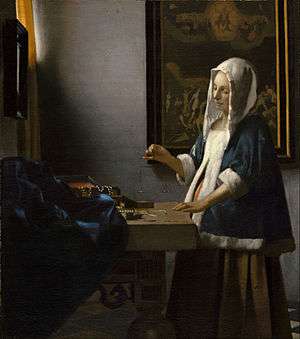Woman Holding a Balance
 | |
| Artist | Johannes Vermeer |
|---|---|
| Year | 1662–1663 |
| Medium | Oil on canvas |
| Dimensions | 42.5 cm × 38 cm (16.7 in × 15 in) |
| Location | National Gallery of Art, Washington, D.C. |
Woman Holding a Balance, also called Woman Testing a Balance, is an oil painting by Dutch Baroque artist Johannes Vermeer.
At one time the painting, completed 1662–1663, was known as Woman Weighing Gold, but closer evaluation has determined that the balance in her hand is empty. Opinions on the theme and symbolism of the painting differ, with the woman alternatively viewed as a symbol of holiness or earthliness.
Theme
In the painting, Vermeer has depicted a young woman holding an empty balance before a table on which stands an open jewelry box, the pearls and gold within spilling over. A blue cloth rests in the left foreground, beneath a mirror, and a window to the left — unseen save its golden curtain — provides light. Behind the woman is a painting of the Last Judgment featuring Christ with raised, outstretched hands.[1] The woman may have been modeled on Vermeer's wife, Catharina Vermeer.[2]
According to Robert Huerta in Vermeer and Plato: Painting the Ideal (2005), the image has been variously "interpreted as a vanitas painting, as a representation of divine truth or justice, as a religious meditative aid, and as an incitement to lead a balanced, thoughtful life."[3] Some viewers have imagined the woman is weighing her valuables, while others compare her actions to Christ's, reading parable into the pearls.[1] Some art critics, including John Michael Montias who describes her as "symbolically weighing unborn souls", have seen the woman as a figure of Mary.[4][5] To some critics who perceive her as measuring her valuables, the juxtaposition with the final judgment suggests that the woman should be focusing on the treasures of Heaven rather than those of Earth.[6] In this perspective, the mirror on the wall may reinforce the vanity of her pursuits.[7]
History
Completed in 1662 or 1663, the painting was previously called Woman Weighing Gold before microscopic evaluation confirms that the balance in her hands is empty.[3][8] The painting was among the large collection of Vermeer works sold on May 16, 1696 in Amsterdam from the estate of Jacob Dissius (1653–1695).[9] It received 155 guilders, considerably above the prices fetched at the time for his Girl Asleep at a Table (62) and The Officer and the Laughing Girl (approximately 44), but somewhat below The Milkmaid (177).[10]
Painting materials
The first pigment analysis of this painting by Hermann Kühn[11] revealed the use of ultramarine for the blue tablecloth and lead white for the grey wall. The pigment in the bright yellow curtain was identified as indian yellow. The subsequent technical investigations of the painting by Robert L. Feller (1974) and M.E. Gifford (1994)[12] have shown that the painting had been extended by approximately five centimetre on every side at a much later date. The sample investigated by H. Kühn in 1968 was unfortunately taken from this extension. The proper pigment of the yellow curtain is lead-tin-yellow. The full pigment analysis according to the latest data is illustrated at Colourlex.[13]
Notes
- 1 2 Huerta (2005), p. 54.
- ↑ Walther and Suckale (2002), p. 332.
- 1 2 Huerta (2005), p. 85
- ↑ Montias (1991), p. 191.
- ↑ Kenner (2006), p. 56.
- ↑ Roskill (1989), p. 148.
- ↑ Carroll and Stewart (2003), p. 61.
- ↑ Montias (1991), p. 162.
- ↑ Montias (1991), p. 182, 256.
- ↑ Montias (1991), p. 182.
- ↑ Kühn, H. A Study of the Pigments and Grounds Used by Jan Vermeer. Reports and Studies in the History of Art, 1968, 154–202.
- ↑ Gifford, E.M., Painting Light: Recent Observations on Vermeer’s Technique, in Gaskell, I. and Jonker, M., ed., Vermeer Studies, in Studies in the History of Art, 55, National Gallery of Art, Washington 1998, pp. 185-199
- ↑ Johannes Vermeer, 'Woman Holding a Balance', Colourlex
References
- Carroll, Jane Louise; Alison G. Stewart (December 2003). Saints, Sinners, and Sisters: Gender and Northern Art in Medieval and Early Modern Europe. Ashgate Publishing, Ltd. ISBN 978-0-7546-0589-8. Retrieved 29 June 2010.
- Huerta, Robert D. (2005). Vermeer and Plato: Painting the Ideal. Bucknell University Press. ISBN 978-0-8387-5606-5. Retrieved 29 June 2010.
- Kenner, T. A. (October 2006). Symbols and Their Hidden Meanings: The Mysterious Significance and Forgotten Origins of Signs and Symbols in the Modern World. Thunder's Mouth Press. ISBN 978-1-56025-949-7. Retrieved 29 June 2010.
- Montias, John Michael (1 January 1991). Vermeer and His Milieu: A Web of Social History. Princeton University Press. ISBN 978-0-691-00289-7. Retrieved 29 June 2010.
- Roskill, Mark W. (June 1989). What is art history?. Univ of Massachusetts Press. ISBN 978-0-87023-675-4. Retrieved 29 June 2010.
- Sweetman, Robert (March 2007). In the Phrygian mode: neo-Calvinism, antiquity and the lamentations of reformational philosophy. University Press of America. ISBN 978-0-7618-3021-4. Retrieved 29 June 2010.
- Walther, Ingo F.; Robert Suckale (1 September 2002). Masterpieces of Western Art: A History of Art in 900 Individual Studies from the Gothic to the Present Day. Taschen. ISBN 978-3-8228-1825-1. Retrieved 29 June 2010.
Further reading
- Liedtke, Walter A. (2001). Vermeer and the Delft School. Metropolitan Museum of Art. ISBN 978-0-87099-973-4.
- Salomon, N. From Sexuality to Civility: Vermeer’s Women, in Gaskell, I. and Jonker, M. ed., Vermeer Studies, in Studies in the History of Art, 55, National Gallery of Art, Washington 1998, pp. 309-322
External links
| Wikimedia Commons has media related to Woman holding a balance by Johannes Vermeer. |
- Johannes Vermeer, Woman Holding a Balance, explore this painting, National Gallery Washington
- Johannes Vermeer, Woman Holding a Balance, Colourlex
- Janson, J., Johannes Vermeer, Woman Holding a Balance, Essential Vermeer, website.